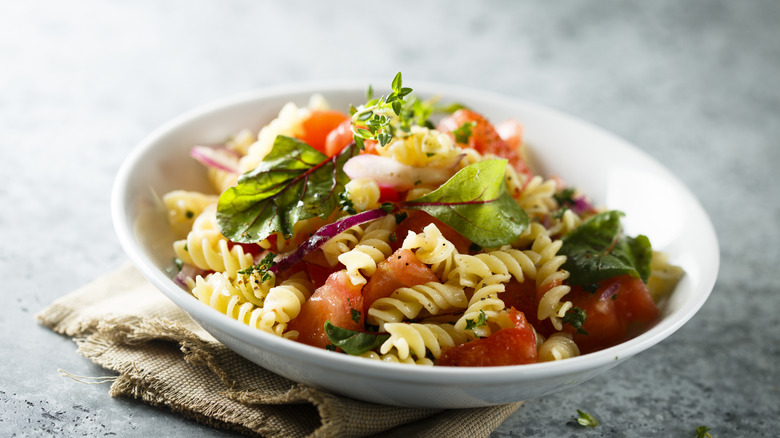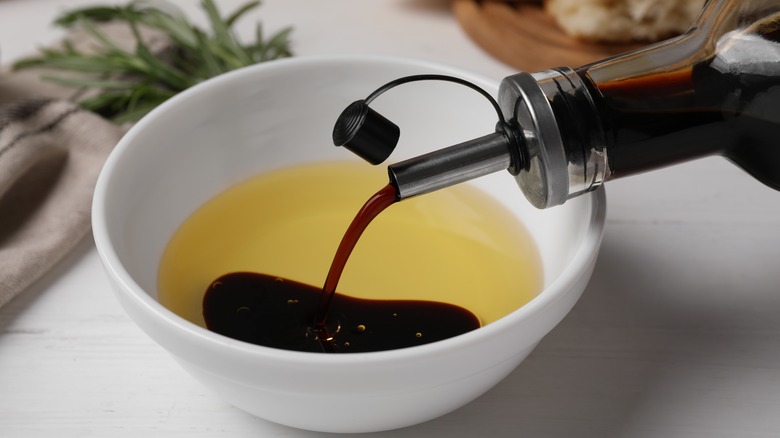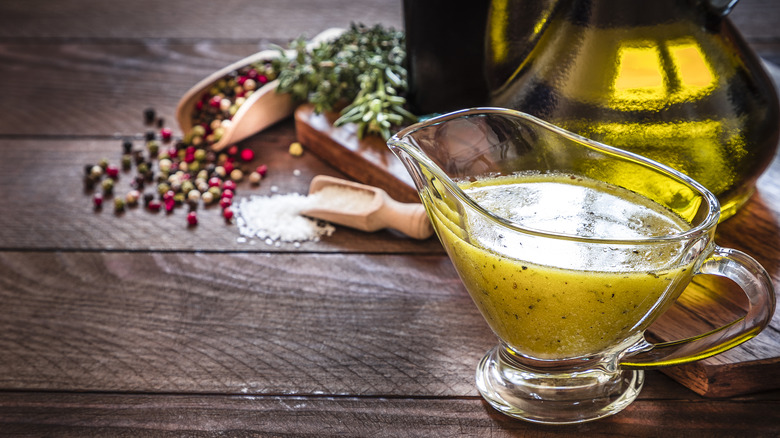You're Dressing Your Pasta Salad All Wrong. Fix It With One Simple Swap
Pasta salad is beloved for its simplicity, portability, and customizability. More a blank slate for experimentation than an actual recipe, pasta salads can be made with endless combinations of noodles, veggies, cheeses, protein sources, and sauces — ranging from salad dressing-style, vinegar-based ones to creamy, rich oil- or mayo-based sauces. Pasta salads can easily be made high-protein, and are the perfect vehicle for using up whatever assortment of produce and bottles of briny olives and peppers you have in the fridge.
Done right, there's nothing better for enjoying at a picnic, potluck, or outdoor warm weather dinner. Done wrong — and done wrong they can be — even a pasta salad made with all the best intentions (and an all-star lineup of ingredients) can still come out flavorless, or often, overly tangy. While acid — be it lemon juice or vinegar — is an essential ingredient for enhancing flavors in nearly every savory dish, if you're leaning too heavily on vinegar to liven up a pasta salad, it's easy to end up ruining the whole meal.
The better way to approach your recipe is to think of pasta salad first and foremost as a pasta dish — not a typical greens-based salad. By adopting this mindset and dressing your pasta salad with richer, creamier, more fat-based dressings instead of pouring in the vinegar and lemon juice, the final creation will ultimately be more balanced, satisfying, and well-rounded in flavor — not in-your-face-tangy.
Too much acidity can ruin your pasta salad
Picture this: You've cooked your noodles, assembled your sauce, chopped veggies like tomatoes, cucumbers, fresh herbs, and have your feta or mozzarella cheese at the ready. You've added your pasta salad ingredients and tossed everything together; then you take the first taste test, only to realize the flavor profile is missing a little something. Thinking it could use brightening up, you attempt to fix it by adding more vinegar — red wine, balsamic, or perhaps lemon juice. Soon, you have an overly bright, tangy salad that's lively in all the wrong ways, leaving you with a saucy, bitter dish that's more salad than pasta. Once your pasta salad flavor has reached this level, there's not much you can do to fully remedy it.
The best solution is to pare way back on the acid sources to begin with, and emphasize fat — that is, an olive-oil-based sauce, with vinegar as a needed accompaniment, but not the star of the show. You can also adjust the type of vinegar you're using, opting for less harsh, acerbic options like white or rice vinegars, or just some spritzes of lemon juice. Pickle juice even works well for a bright, not bitter flavor! And don't underestimate what pickled and briny ingredients add — like capers, kalamata olives, marinated artichoke hearts, pepperoncini, and the like. They too pack a punch of sour tang, so all the more reason to cool it on the vinegar.
Dress your pasta salad as though it's a warm pasta dish
All pasta lovers know that a satisfying, indulgent pasta dish needs a healthy dose of fat — from emollient sauces and creamy add-ins. Don't throw your pasta wisdom out the window just because the dish you're serving in this case will be chilled. Think of your pasta salad as a cooled-off version of a classic warm olive oil and garlic noodle dish, and dress it accordingly. This will help prevent an overly sour vinegar bomb.
For a foolproof ratio of fresh, vibrant dressing that's not overpoweringly tangy, start with olive oil, and use at least a 2:1 fat to acid ratio — in other words, at least double the amount of olive oil compared to vinegar. (This is an instance where you might want to break out your bottle of premium olive oil.) Of course, as with all pasta salads, this is less of a hard-and-fast rule and more of a guideline — you can certainly adjust to your personal preference depending on the other ingredients you're adding.
In general, though, rely on ingredients like minced garlic, fresh or dried herbs, salt and pepper, and your veggies to add lively flavor — and just a few tablespoons or so of vinegar or lemon juice. With other easy steps — like ensuring all ingredients are uniformly chopped so each bite delivers a rainbow of colors and flavorful elements — more flavorful pasta salads are in your future.


